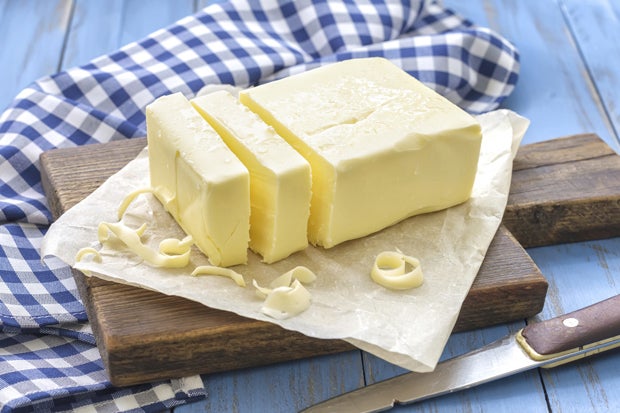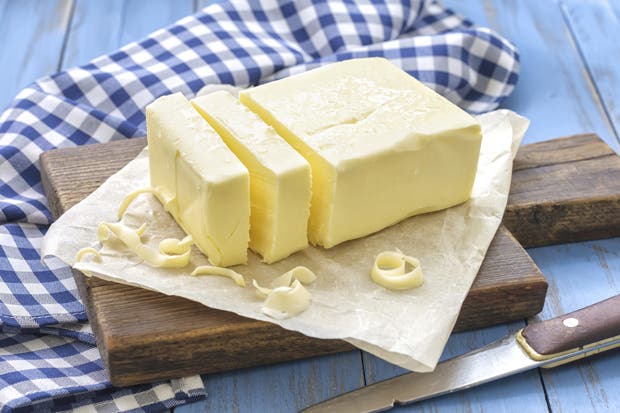Is Butter Better?

Butter

We understand why you’re confused in the butter aisle. We’ve been told that butter is bad for us, but it turns out some of the alternatives aren’t any better. So what to choose? These days the number of options for your baking or morning toast has never been larger. It’s enough to leave you cross-eyed and ready to make a hasty retreat for the frozen-food aisle. While some spreads deliver rich flavor and nutritional perks, there are others that can torpedo your diet (and your health) with sketchy ingredients. Read on for help in deciphering the science from the sales pitch.
Butter
Regular butter is made with one ingredient: cow’s milk or cream, churned until it reaches a semisolid state with at least 80 percent milk fat by weight. While its lofty saturated fat was once its undoing, old-school butter is experiencing a renaissance as people return to more wholesome foods. Furthering its newfound popularity are studies that are now suggesting saturated fat is not nearly the health pariah it was made out to be. Case in point: A 2014 review of studies published in the Annals of Internal Medicine suggests that current evidence does not support a strong link between saturated fat intake and heart disease. Previous studies have pinpointed items like trans-fatty acids and highly processed carbohydrates as potentially bigger culprits in promoting coronary woes.
Still, butter has a steep calorie count—100 calories with 11 grams of fat for each tablespoon serving — so to keep your calorie intake in check, it’s wise to use it in moderation. Read: Go easy on the all-butter crust pies!
Choose Wisely: Hormones and antibiotics used on cattle can concentrate in their butterfat. To limit your exposure, opt for organic brands if possible. Go one step further by searching out butter gleaned from pasture-raised cattle. Not only does butter from grass-fed animals have a superior flavor, studies suggest that the milk they produce, and in turn the butter made from it, is nutritionally superior, such as containing higher levels of heart-healthy omega-3 fatty acids.
If you’re concerned about calories, look for whipped butter from brands like Organic Valley. The process of whipping introduces air into the butter, making it less calorie dense and easier to spread straight from the fridge than regular butter. You may also find cultured butter, a rich butter made from cultured cream that’s popular in Europe and may contain beneficial bacteria similar to that found in yogurt.
Regular Margarine
Vegetable oil–based margarines surged in popularity as health experts claimed that eating saturated fat was akin to pouring superglue into your arteries. So an unsuspecting public started to forgo butter in favor of slathering margarine on their grilled cheese.
But to get vegetable oil to solidify into a spreadable product, food manufacturers partially hydrogenate the oil, creating the now-infamous trans fat. Research is now clear that unlike the saturated fat that it replaced, no amount of trans fat intake is safe. Even intakes below a gram a day have been linked to a host of health woes, including heart disease and diabetes. What’s more, researchers in Denmark found that women with higher levels of trans fat in their adipose (fat stores) were more likely to be overweight.
Choose Wisely: Check the ingredients of any margarine you’re considering buying: If it includes the word “hydrogenated,” steer clear as it has some trans fat even if the label says “trans fat free.” The FDA created a loophole where if a product contains less than 0.5 grams of trans fat per serving, the company can claim it’s free of this killer fat. Today, stick margarine is the most likely to contain trans fat.
Trans-Fat-Free Margarine
As word spread about the health perils of trans fatty acids, a number of companies saturated the market, so to speak, with soft, trans-fat–free buttery spreads made with vegetable oils that were not hydrogenated. While on paper these products seem like a smart buy, in reality they can have their own set of dietary pitfalls. Some brands are pumped full of highly processed oils such as soybean and corn that are loaded with omega-6 fatty acids. An excessive intake of omega-6s when paired with an inadequate intake of omega-3s is thought to encourage inflammation in the body that can spiral into a number of maladies including heart disease. And keep in mind that vegetable oils pack in just as many calories as butter, so many of these spreads are not nearly the calorie savings many people think they are.
Often these products also sport a long list of ingredients that only a chemistry whiz would be able to decipher. While many like mono- or diglycerides are used to help keep the product stable are harmless, those wishing to live a whole-food lifestyle may find the simple ingredient list of old-fashioned butter easier to swallow. If baking is your thing, also keep in mind that many people find these spreads produce poor results in items like pies and cakes.
Choose Wisely: Look for brands that include extra virgin olive oil in their mix for a shot of artery-friendly monounsaturated fat and less of the inflammatory omega-6 type. To stay in bikini-body shape, also opt for those with no more than 60 calories in a single tablespoon. You can also now find tubs elevated with some useful add-ins like flaxseed, vitamin D and sterols, plant compounds found to shave down cholesterol numbers.
Vegan Buttery Spreads
A godsend for vegans or the lactose intolerant, these spreads often use a combination of vegetable oils, including palm and canola, along with natural flavoring of unknown origin for its “buttery” essence and a coloring agent like annatto, derived from the seeds of the achiote tree. As with coconut oil and the milk fat used to make butter, the oil gleaned from the fruits of palm trees is a source of saturated fat. However, it appears that the type of saturated fatty acids in palm oil have a neutral impact on heart health. In fact, the natural reddish hue of palm oil is a tip off that it also contains a fair amount of heart-chummy carotenoids.
Now on the market are also vegan shortenings made with either 100 percent palm oil or a mixture of palm oil and coconut oil. Solid at room temperature, these are a definite upgrade from the trans-fat–laden Crisco. You can use these Paleo-worthy shortenings like you would butter or shortening in most recipes such as pie crust.
Choose Wisely: It’s important to look for brands such as Nutiva that source their palm oil sustainably, as monoculture palm plantations are having a devastating impact on Asian forests and the wildlife they provide a home for. If you’re trying to sidestep genetically modified foods, you’ll also want to keep an eye for companies like Earth Balance that use non-GMO canola and/or soybean oil. The best non-dairy shortenings will use unrefined or expeller-pressed oils, which means no harsh chemicals were used to extract the oils from the palm fruit or coconut.